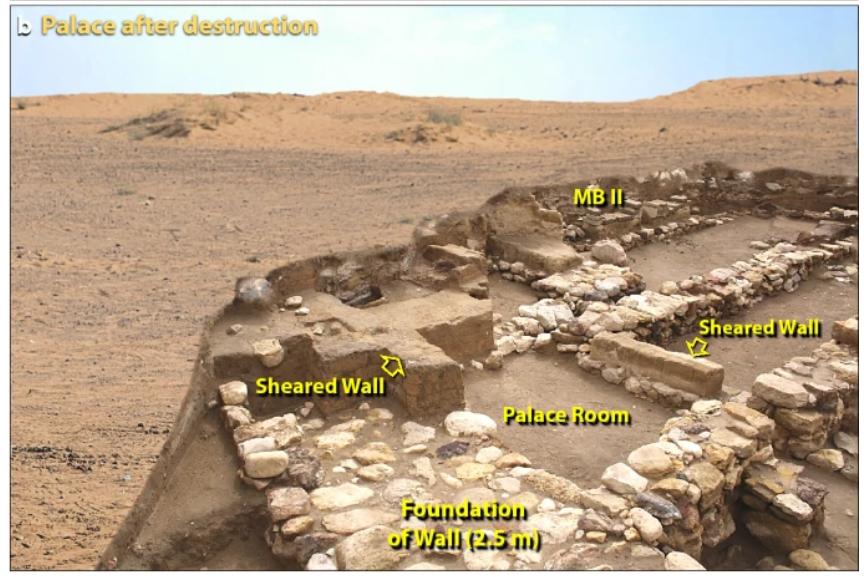
These are just some preliminary observations on #TalElHammam and #TEHburst, But I thought they were worth mentioning. As a geoarchaeologist working (amongst other things) on a palatial destruction, I have some thoughts.
https://twitter.com/MarkBoslough/status/1440816755161518082?s=20
I primarily study #micromorphology, I look at dirt under a microscope to understand how it ended up where I found it. This could be anything from agricultural soil to ta clay floor. I often try to figure out how sediment is transported or altered.
doi.org/10.1016/j.jasr…
doi.org/10.1016/j.jasr…
Simply put, it doesn’t seem to me that the sediments at #TallElHammam match up with the interpretation by Bunch et al. At all.
Their interpretation of the destruction within the palace rests on the presence of burning evidence, debris, and finely laminated sediments. The “blast” forces debris through the building, destroys, then the wind buries everything. There are some issues with this. 

First: there isn’t anything strange about the debris. Or even the “missing mudbricks.” Mudbrick decays, even in deserts. Collapsed mudbrick ends up incorporated in with wind-blown sediments. Bunch et. al apparently fabricated a mystery.
doi.org/10.1016/j.jas.…
doi.org/10.1016/j.jas.…
Speaking of the wind, Bunch et al. claim that wind conditions weren’t sufficient to erode the walls (which they suggest were ‘sheared’ by a shock wave, which doesn’t make tremendous sense). However, in their diagram, they miss erosion (red line added) likely caused by wind 

This extra stratigraphic feature suggests that the walls were actually exposed for some time, long enough for them to be eroded down. The so called “debris matrix” is likely just the remains of collapsed and decayed bricks. This could easily be tested with #micromorphology.
Another misidentification seems to be the broken pottery supposedly smeared in the direction of the “debris cloud” movement. However, the sherds are not aligned as they would by wind or water. Their axes would be perpendicular or parallel to the direction of travel, not random. 

You can read more about transport and orientation here, at @FlintDibble’s thread, but the point is that these pots were not drawn out by a strong wind or moving sediment. They likely fell and shattered in this fashion.
https://twitter.com/FlintDibble/status/1163435944642588673?s=20
Then there’s the problem of equifinality, This has been pointed out for the supposed diamonoids found in the study, but it also applies to the shocked quartz, which is caused by rock formation processes, tectonics, and even lightning.
https://twitter.com/elleryfrahm/status/1440714921340071939?s=20
Also, the dating is suspect. They focused on dating the destruction layer, rather than a whole sequence, and the “destruction” could easily have happened over 300 years.
https://twitter.com/joeroe90/status/1440443321894064136?s=20
Then there are the claims about temperatures reached in air-bursts, which are exaggerations.
https://twitter.com/michael_w_busch/status/1440460910355628036?s=20
Oh, and the melted material looks suspiciously anthropogenic
https://twitter.com/NErbSatullo/status/1440615036691501059?s=20
And the bones, which aren’t fully reported. Here too, no effort appears to have been made to understand stratigraphic context or the actual taphonomy of the bones.
https://twitter.com/petrabonegirl/status/1440833392006688768?s=20
The article is all over the place. They didn’t correctly observe the stratigraphy, and the so-called “impact proxies” cannot be securely linked to an airburst or impact. This is #ShoddyScience at best, #Pseudoarchaeology at worst
Thanks for reading, stay tuned for more science from your friendly neighborhood Soil Man.
All images from:
Bunch et al. 2021. A Tunguska sized airburst destroyed Tall el-Hammam a Middle Bronze Age city in the Jordan Valley near the Dead Sea. Scientific Reports
All images from:
Bunch et al. 2021. A Tunguska sized airburst destroyed Tall el-Hammam a Middle Bronze Age city in the Jordan Valley near the Dead Sea. Scientific Reports
• • •
Missing some Tweet in this thread? You can try to
force a refresh





